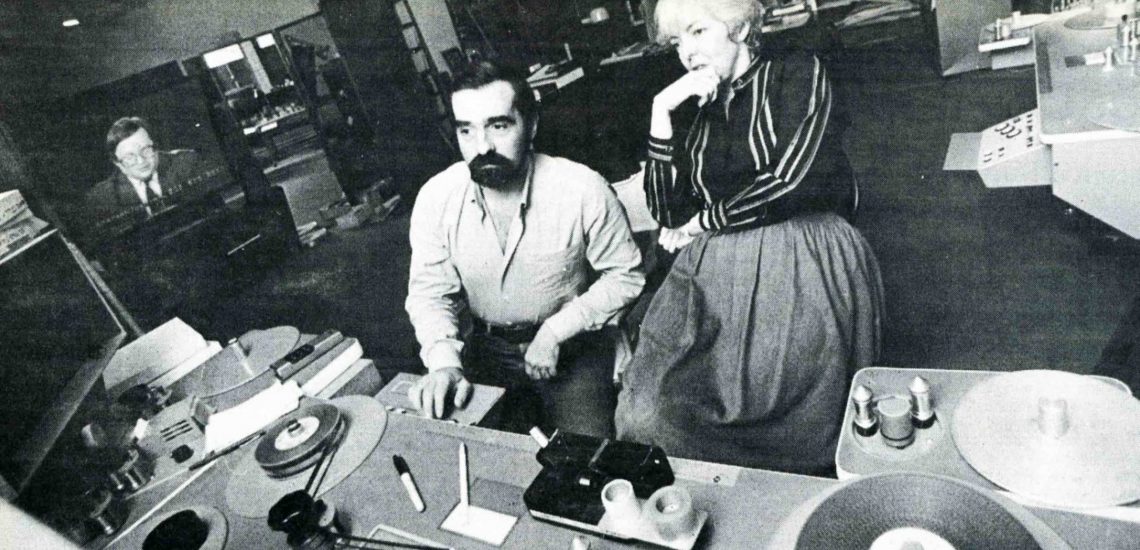1. Auteur Theory: The Film Editor vs. the Theorists
The necessity for an ‘auteur’, of course, is not absolute. In laying the foundations for this study it is pertinent to consider how and why the theory developed, and how it applies today. The first proposition of the auteur in film dates back to the French film journal Cahiers du Cinéma in the 1950s, and particularly the essays, therein, of critic François Truffaut and theorist André Bazin (Wharton & Grant, 2005, p. 19). In his 1954 article, Truffaut introduced ‘la politique des auteurs’, a stance opposing the then dominant tradition in French cinema of attributing the central creative role to the writers, and relegating the directors to that of a subordinate (Caughie, 1981, p. 35). Even from these early beginnings, similarities arrive with the proposed debate for this dissertation. There is a suggestion that in the sixty years since, the creative impetus has shifted and spread to other roles in the same manner as Truffaut theorised it shifted from the writer to the director in the 1950s. Truffaut’s stance, however, would ultimately paint the director as the auteur by default for decades to come.
Of course, in today’s cinema, there are several key examples where creative acclaim has in fact shifted back to the writer. In a sense, this is a return to Alexandre Astruc’s idea of ‘la caméra-stylo’, a stance on authorship that pre-dates Truffaut and places the emphasis of creativity on narrative rather than visual image (Darke, 2007, p. 401). Amongst these are blockbuster event movies such as the James Bond and Harry Potter series, best known as the creation of their writers, Ian Fleming and J. K. Rowling respectively. In these examples, it can be argued that directors simply realise the creative thoughts of another individual, rather than express and develop their own. The question that this presents is how this is any different than adapting any other film screenplay? On this point, Truffaut emphasised ‘mise en scène’, the visual qualities, as the defining artistic difference between the writer and the director (Caughie, 1981, pp. 36-37). Yet mise en scène is still often only a director’s representation of somebody else’s vision, and it can certainly be argued that editors interpret and reinterpret such vision in their own way too.
However, claims for authorship go deeper than this. Truffaut (1954, cited by Caughie, 1981, pp. 39-40) endeavoured to define the difference between what he considered a ‘hommes de cinéma’, or film auteur, and a ‘metteur en scène’, a director who despite assembling the mise en scène, does not achieve distinction as the individual creative influence behind a film. ‘[Directors] Yves Allégret and Dellanoy are only caricatures of Clouzot, and of Bresson … these are the audacities of hommes de cinéma, and no longer of scenarists, metteurs en scène, or littérateurs’ (Truffaut, 1954, cited by Caughie, 1981, p. 40). If the editor is to be incorporated into this theory, where along the scale between metteur en scène and hommes de cinéma does the role fit?
To gauge the validity of this debate, it is first important to reinforce filmmaking’s credibility as an art form, and within that the creative importance of the editing process. Ultimately the merit of an artist is judged mostly from individual expressionism, an idea developed in the Romanticism period between 1780 and 1848 (Wharton & Grant, 2005, p. 17). This period saw a cultural shift from the use of classical models in existing art forms, and a new emphasis on originality, imagination, and freedom of expression. However, Romanticism also saw changes to the consumption of art; ‘Art became subject to economic forces; the dilemma for the artist was more obviously between artistic integrity and pleasing the public’ (Wharton & Grant, 2005, pp. 17-18). From this statement, the parallels with filmmaking begin to arise. If art is to be distributed and exhibited for both public approval and public funds, be it a painting in an art gallery or a Hollywood blockbuster, how does this impose on and restrict the artistic side? If a painting is undeniably art despite such imposition and financial motivation, what makes film any different?
It is in this attempt to credit film as a true artistic medium that the merits of auteur theory’s initial inception become clear. As Watson (2007, p. 96) writes; ‘some fifty or so years ago, when not altogether ignored by scholars as beneath serious critical attention, cinema was often vilified along with other forms of mass culture as a blemish on art, or worse, a dehumanising agent of cultural oppression’. Ultimately, pre-auteur theory, the case for cinema as art struggled against three main arguments; it was technologically in advance of other art forms; it was a collaborative process and divided labour; and it was engineered to entertain the masses, resulting in certain standards and conventions having to be obeyed (Watson, 2007, p. 96). Watson (2007, p. 96) continues; ‘In all of these propositions the blanket rejection of cinema as artistically illegitimate depends on the idea that art is necessarily the result of the creative activities of an individual, and can be appreciated and understood as such’.
Effectively, auteur theory was a tool for addressing such criticism. Only since its introduction has film evolved into both a serious artistic, and academic, discipline, as Dyer (1998, p. 5) writes:
[Authorship] made the case for taking film seriously by seeking to show that a film could be just as profound, beautiful and important as any other kind of art, provided, following a dominant model of value in art, it was demonstrably the work of a highly individual artist … Thus, at a stroke, it was proclaimed that film could be art (with all the cultural capital this implies) and that there could be a form of criticism – indeed, study – of it.
Film theorist André Bazin (cited by Caughie, 1981, pp. 45-46) believed that filmmaking was, indeed, an art form. What he questioned was the necessity of any one individual being praised above the film itself, in the way that authorship implies:
The American cinema is a classical art, but why not then admire in it what is most admirable, i.e. not only the talent of this or that film-maker, but the genius of the system, the richness of its ever-vigorous tradition, and its fertility when it comes into contact with new elements … This does not mean that one has to deny the role of the auteur, but simply give him back the presupposition without which the noun auteur remains but a halting concept. Auteur, yes, but what of? (Bazin, cited by Caughie, 1981, pp. 45-46).
He essentially defines film as artistic, but argues that the need for a designated auteur is outweighed by the necessity to appreciate the film as a whole, for all its elements. The supposed auteur, of course, is only one of those elements. Amongst the many others lies the editing. Bazin’s theory may not specifically address the editor or the process of editing, but it works at least as a method for casting doubt on the traditional idea of the director, exclusively, as the auteur. Instead, what he begins to acknowledge is the collaborative nature of filmmaking – not just industrially, but creatively. It is a gauntlet later picked up by Gaut (1997, p. 150), discussing the notion of ‘multiple-authorship’. Simply put, his theory keeps many of the essential principles of authorship, but adapts to acknowledge more than just a single creative influence. If this is to be the accepted critical construct, it certainly begins to credit the editing of a film as a key identifier of authorship, at least jointly.
Such collaboration is largely unique to the film industry, but not unheralded in other mediums. For example, there are debates over where the true artistry for Rembrandt’s painting Polish Rider truly lies (Vogel, 1997). This opens up creative debates over authorship in art in much the same way as auteur criticism in film. Ultimately, it does not appear degrading to the valorisation of film as art to welcome collaboration. Yet, if the Polish Rider is to be described as a ‘Rembrandt’, similarly, a film must also benefit from such artistic ownership. The debate that remains is whether a film such as Apocalypse Now (1979) is a ‘Francis Ford Coppola film’, after the director, or for the purposes of this argument, a ‘Walter Murch film’, after the editor’s unrelenting efforts in reconstructing over 230 hours of footage into a critically successful film (Murch, 2001, pp. 5-6).
The problem theorist Roland Barthes saw with such ownership of a text, though, was the influence of the reader; ‘a text is made of multiple writings, drawn from many cultures and entering into mutual relations of dialogue, parody, contestation, but there is one place where this multiplicity is focused and that place is the reader, not, as was hitherto said, the author’ (Barthes, 1981, p. 212). In this theory’s application to film, it is the audience that creates meaning to what is essentially a realm of mixed writings – ‘it is impossible to attribute authorship to an individual director as s/he can only recycle formula and convention’ (Wharton & Grant, 2005, p. 23). As Barthes (1981, p. 213) states; ‘a text’s unity lies not in its origin but in its destination’. What emerged from this was the ‘death of the author’, an understanding that the audience will bring their own interpretations to a film based on experience and attitudes (Phillips, 2007, p. 160). When analysing the role of editing against this theory, the idea of recycling convention especially comes to fruition, owing to the many established techniques of the practise. How this affects the editor’s claim for authorship will be discussed in greater depth in chapter three, though ultimately Barthes’ interpretation negates authorship altogether, not just in the case of the editor.
Despite Barthes’ denouncement of the author, however, its presence is felt even today. Relating back to the concept of authorship in commerce, the film industry latched on to the idea of the auteur and reworked it into an effective marketing tool. Indeed, this was even commonplace in other forms. The primary reason such controversy exists over the Polish Rider was that the Rembrandt tag would increase the salability of the work (Vogel, 1997). In film, by the 1990s, Corrigan (1991, cited by Watson, 2007, p. 101) argued that auteurism had evolved into ‘a commercial strategy for organizing audience reception, as a critical concept bound to distribution and marketing aims … in today’s commerce we want to know what our authors or auteurs look like or how they act’. At this point, auteur theory descends somewhat into the avenue of star studies. The auteur, most likely the director, has a public image and an established body of work that production companies tap into to promote their next film, much like a film ‘star’ (Watson, 2007, p. 101). Again, this is consistent with other artistic mediums, a key example of which is the recent rise to prominence of the play Double Falsehood, under claims that it is a ‘lost’ work of Shakespeare (Brown, 2010).
This is where an absolute contrast between the public image of a director, and the public image of an editor, presents itself. There is no doubt that a director such as Quentin Tarantino fits the celebrity model outlined above. The same cannot be said for the likes of Sally Menke, Ralph Rosenblum, or Thelma Schoonmaker. Even Walter Murch, perhaps the most well-known of editors, does not accrue celebrity status in the same way. The debate this presents is whether this is a cause, or indeed an effect, of establishing the director as the auteur. Brownlow (1968, p. 280) describes editing as a ‘hidden art’. It is just that – hidden. Similarly, Rosenblum and Karen (1979, p. 68) write:
The very nature of the process tended to obscure talent. Not only was it impossible to assign credit for a masterful editing job, most viewers, aficionados included, had no way of spotting it. The purpose of editing was to cover its traces.
This is not to say, necessarily, that their role is any less integral, just that a director will naturally march towards authorship due to their colonel-like presence on set and in the public eye. As a result, the overlooking of the editing process as a staple of authorship is down to purely non-artistic reasons. Yet it is difficult to argue against the process of editing as artistic. In Andrew Sarris’ writing on auteur theory, he outlines three criteria that he perceives a director must achieve to be promoted to the level of auteur – three criteria equally applicable to editing. Sarris (2004, p. 562) writes; ‘the first premise of the auteur theory is the technical competence of a director as a criterion of value. A badly directed or undirected film has no importance in a critical scale of values’. The measure of technical competency in editing is largely clear, and a key discussion in chapter three. Though, this one criterion alone does not separate an auteur from a metteur en scène.
However, the remaining criteria do begin to achieve this; ‘The second premise of the auteur theory is the distinguishable personality of the director as a criterion of value. Over a group of films, a director must exhibit certain recurrent characteristics of style, which serve as his signature’ (Sarris, 2004, p. 562). Though, there are also contrasting styles and techniques in editing. Reisz and Millar (1984, pp. 69-209) outline meticulously the varying practices of editing across different genres, from action to comedy. If directors such as Tim Burton define their signature by revisiting the same genre with similar themes and characteristics, it should be safe to assume that an esteemed editor will also have their own preferences on such matters, and add to their body of work accordingly. Walter Murch, for example, has worked on numerous war-related films; Apocalypse Now (Coppola, 1979), The English Patient (Minghella, 1996), K-19: The Widowmaker (Bigelow, 2002), Cold Mountain (Minghella, 2003), and Jarhead (Mendes, 2005). These films all contain similar editing methods that set them aside from, say, romantic comedies, and Murch would have been well aware of this as he built them into his auteur-like collection of films.
‘The third and ultimate premise of the auteur theory is concerned with interior meaning, the ultimate glory of the cinema as art. Interior meaning is extrapolated from the tension between a director’s personality and his material’ (Sarris, 2004, p. 562). Though this idea conflicts with the theories of both Bazin and Barthes, it is an understanding that perfectly frames film as a legitimate art form. Shifting this premise onto the editor is somewhat more difficult, and there appear to be two ways to tackle this. The first is through Pauline Kael, who in her article Squares and Circles (1963) vehemently disputes Sarris’ theory, and indeed auteur criticism as a whole:
“Interior meaning” seems to be what those in the know know. It’s a mystique – and a mistake. The auteur critics never tell us by what divine rods they have discovered the élan of a Minnelli or a Nicholas Ray or a Leo McCarey (Kael, 1963, p. 20).
Put simply, the notion of interior meaning is too ambiguous to define authorship, so whilst Kael’s argument does not necessarily valorise the work of the editor in this respect, it somewhat discredits the idea that a director is any further up the hierarchy as a result of such interior meaning. The second approach, if Sarris’ theory is to be insisted upon, is that his understanding of an auteur’s work reflecting the soul – that ‘intangible difference between one personality and another … expressed by no more than a beat’s hesitation in the rhythm of a film’ (Sarris, 2004, p. 563) – does not apply exclusively to the director. Intangible differences between personalities occur throughout film production, and ultimately it is the differences the editor has with the director that most shape the film in its final stages. That Sarris would use the example of rhythm, a key concept in editing, is only further testament to this.
It is also interesting that Sarris (2004, p. 563) acknowledges Eisenstein and Griffith as auteurs, giving that they are considered two pioneers in the formation of editing practice. Amongst Eisenstein’s theories on editing is the idea of ‘montage’ and ‘shock attraction’, the juxtaposition of two images ‘in such a way as to evoke an idea or a feeling that went beyond the sum of its parts’ (Rosenblum & Karen, 1979, p. 48). Eisenstein himself further adapted the idea of montage from a mere combination of unrelated images into five distinct methods of montage – metric, rhythmic, tonal, overtonal, and intellectual – each used to convey feeling and thought differently (Eisenstein, 1949/1977, pp. 72-83). Of course, Eisenstein was one of the Bolshevik filmmakers of the 1920s, a purely political Marxist movement that emphasised work as the ‘basis for all value in film … [that] the essential motion in film was not the motion that went on before the camera, but the motion that was created from cut to cut’ (Rosenblum & Karen, 1979, p. 46). Eisenstein’s school of editing was essentially about showcasing the graft of the cutters, hence ‘shock attraction’, and presenting the editing as the ‘creation’ of the film.
Griffith’s style and agenda were entirely different. His form of editing was purely about preserving continuity, through the use of cutting-on action; ‘In the later classical style of “invisible editing”, cutting-on a gesture guaranteed continuity over shots … This distracts spectators from the cut, masking the discontinuity of shot change with the continuity of action’ (Gunning, 1991, p. 115). Essentially, this idea contrasts with Eisenstein purely through the act of masking the work of the editor, making him or her invisible. Pearlman (2009, p. 154) argues that the two styles are not mutually exclusive however, merely opposing points on a scale between montage and decoupage. The question remains whether this makes both Eisenstein and Griffith auteurs under Sarris’ criteria. Again, the concept of the auteur is ambiguous, but if this is the case, it is primarily through their innovations in editing that it is so.
Whilst both Eisenstein and Griffith plied their trade as directors, their emphasis on editing at least opens up the possibility that an editor can, indeed, be the auteur on a certain film if he or she has added a sufficient amount of their own creative and artistic license. Yet, as has been discussed, the concept of the auteur is difficult to pin down just one individual, and of course, there are many different adaptations of the theory in critical history. This chapter has touched on a few, but has neglected others. Though, it is because of such uncertainty around the notion of the auteur that this dissertation can exist and challenge the exalted position of the director. As Wollen (2004, p. 565) writes; ‘[auteur theory] was never elaborated in programmatic terms, in a manifesto or collective statement. As a result, it could be interpreted and applied on rather broad lines … within a loose framework of common attitudes’. If this chapter has sufficiently shown film to be an artistic medium, and within that also the practice of editing, then the case is very much put forward that the theory can be further adapted to include the editor as a potential auteur.






Leave A Reply